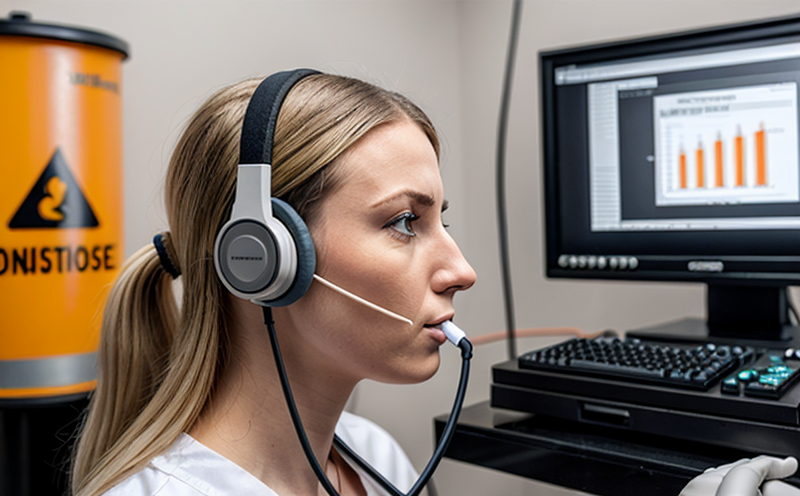ISO/IEC 17025 Accreditation Testing for Noise Laboratories
The process of obtaining ISO/IEC 17025 accreditation for noise laboratories is a rigorous and comprehensive evaluation designed to ensure that the laboratory meets internationally recognized quality standards. This accreditation recognizes the competence of the laboratory in carrying out tests, measurements, or other specific tasks related to occupational noise exposure.
Occupational noise exposure testing aims to quantify and control the levels of noise at which workers are exposed over time. The primary goal is to prevent hearing loss and ensure that employees' health and safety are protected by adhering to regulatory standards such as OSHA (Occupational Safety and Health Administration) in the United States, EU Directives, and other national regulations.
The ISO/IEC 17025 accreditation process involves a detailed assessment of the laboratory's technical capabilities. This includes evaluating the proficiency of personnel, the adequacy of equipment, the accuracy and reliability of test methods, and the overall quality management system (QMS). Compliance with this standard ensures that all noise measurement activities are conducted in a consistent, accurate, and reproducible manner.
For occupational noise exposure testing, the laboratory must have specific expertise. This includes understanding the physiology of hearing loss, the effects of different frequencies on human perception, and the appropriate use of dosimetry devices such as personal sound level meters (PSLMs) and audiometers. The lab should be able to perform a variety of tests including noise dose calculations, time-weighted average noise levels (L
The accreditation process also involves periodic audits and re-evaluations to ensure continuous compliance with the standard. This ensures that the laboratory remains competent in all aspects of its testing activities. The benefits of ISO/IEC 17025 accreditation extend beyond mere compliance; it enhances the reputation of the laboratory, builds trust with clients, and can lead to increased business opportunities.
Obtaining this accreditation is a significant undertaking that requires careful planning and execution. It involves not only the technical aspects of noise testing but also the administrative processes involved in setting up a robust quality management system. The following sections will delve deeper into the benefits, environmental contributions, use cases, and frequently asked questions related to ISO/IEC 17025 accreditation for noise laboratories.
Benefits
The primary benefit of obtaining ISO/IEC 17025 accreditation is the assurance that the laboratory meets internationally recognized quality standards. This accreditation provides a clear demonstration to clients and stakeholders that the laboratory is competent in carrying out noise exposure testing.
- Credibility: It enhances the reputation of the laboratory, making it more attractive to potential clients.
- Trust: Clients can trust the results produced by an accredited laboratory, which can lead to increased business opportunities.
- Regulatory Compliance: By adhering to ISO/IEC 17025 standards, the laboratory ensures that it is in compliance with regulatory requirements.
- Continuous Improvement: The accreditation process encourages continuous improvement of all aspects of the laboratory's operations.
In addition to these direct benefits, obtaining this accreditation can also lead to improved internal processes and better resource management. It provides a framework for ensuring that all testing activities are conducted in a consistent and accurate manner, which is crucial for maintaining high standards of service.
Environmental and Sustainability Contributions
The process of obtaining ISO/IEC 17025 accreditation can contribute positively to environmental sustainability. By ensuring that noise exposure testing is conducted in a consistent and accurate manner, the laboratory helps to prevent overexposure to harmful levels of noise, which can have significant impacts on both human health and the environment.
- Reduced Noise Pollution: By accurately measuring and controlling noise levels, the laboratory contributes to reducing noise pollution. This, in turn, can lead to improved quality of life for communities near industrial areas or airports.
- Health Benefits: By preventing occupational hearing loss, the laboratory helps to improve public health outcomes. This is particularly important in industries where workers are exposed to high levels of noise on a regular basis.
The accreditation process also encourages laboratories to adopt sustainable practices in their operations. This can include minimizing waste, reducing energy consumption, and promoting a culture of continuous improvement. By adopting these practices, the laboratory not only contributes to environmental sustainability but also sets an example for other organizations working in similar fields.
Use Cases and Application Examples
| Use Case | Description |
|---|---|
| Audiometric Testing: | This involves measuring the threshold of hearing at different frequencies. It is used to determine if an individual has suffered from noise-induced hearing loss. |
| Noise Dosimetry: | This measures the time-weighted average noise level (L |
| Acoustic Testing for Machinery: | This involves measuring the sound power or sound pressure levels of machinery to ensure compliance with noise regulations. |
| Environmental Noise Assessment: | This is used to assess noise levels in urban and rural environments, helping to identify areas where noise pollution is a problem. |
- Audiometric Testing: This type of testing is crucial for identifying workers who may be at risk of hearing loss due to prolonged exposure to high levels of noise. It involves the use of audiometers and personal sound level meters (PSLMs) to measure the threshold of hearing.
- Noise Dosimetry: This test measures the time-weighted average noise level experienced by a worker over an 8-hour period. It is used to ensure that workers do not exceed safe noise exposure limits as defined by regulatory bodies such as OSHA and EU Directives.
The use of ISO/IEC 17025 accredited laboratories ensures that these tests are conducted in a consistent and accurate manner, providing reliable data for decision-making. The following section will address some frequently asked questions related to this service.





